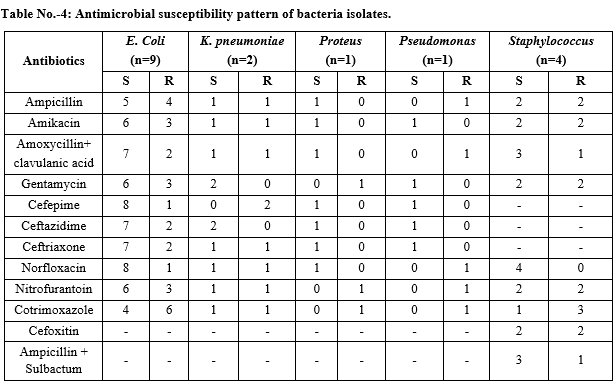Bacterial profile and antimicrobial susceptibility pattern of asymptomatic urinary tract infections among pregnant women attending antenatal clinic at tertiary care hospital in central India
Abstract
Introduction: It is estimated that 2 to 10% of pregnant woman suffer from any form of urinary tract infections. These infections complicate up to 20% ofpregnancies and are responsible for the majority of ante-partum admissions to the maternal-fetal medicine units.
Material and methods: It was a cross sectional study conducted in the Department of Microbiology, Peoples College of Medical Sciences & Research Center, Bhopal (M.P) during period of July 2015 to March 2016. A total of 210 pregnant women having asymptomatic bacteriuria during the period of July2015 to March 2016 attending antenatal clinic were included (all trimester) in this study.
Results: Women in age group 21-30years showed the highest incidence of asymptomatic bacteriuria (70.58%), incidence of asymptomatic bacteriuria was generally high throughout pregnancy, but relatively highest during the second trimester. Escherichia coli was the most common 9 (52.94%) followed by Staphylococcus aureus 4 (23.52%), Klebisella pneumonia 2(11.76%) among the isolates. E.coli was found to be sensitive to cefepime and norfloxacin followed by ceftazidime ceftriaxone amoxicillin + clavulanic acid, nitrofurantoin, gentamycin and amikacin.
Conclusion: This study revealed 8.09% prevalence of asymptomatic bacteriuria among pregnant women. This is of concern because UTI in pregnancy may have serious consequences for both the mother and the child.
Downloads
References
2. Lee M, O'Brien P. Pregnancy and multiple sclerosis. J Neurol Neurosurg Psychiatry. 2008; 79 (12): 1308-1311. doi: 10.1136/jnnp.2007.116947.
3. Sheffield JS, Cunningham FG. Urinary tract infection in women. Obstet Gynecol. 2005;106(5 Pt 1):1085-1092. doi:10.1097/01.AOG.0000185257.52328.a2
4. Stamm WE, Hooton TM. Management of urinary tract infections in adults. N Engl J Med. 1993; 329 (18): 1328-1334. doi:10.1056/NEJM199310283291808
5. Najar MS, Saldanha CL, Banday KA. Approach to urinary tract infections. Indian J Nephrol. 2009;19(4): 129-139. doi: 10.4103/0971-4065.59333.
6. Hazhir S. Asymptomatic bacteriuria in pregnant women. Urol J. 2007 Winter;4(1):24-7.
7. Schnarr J, Smaill F. Asymptomatic bacteriuria and symptomatic urinary tract infections in pregnancy. Eur J Clin Invest. 2008;38(2):50-57.doi:10.1111/j.1365-2362. 2008. 02009.x.
8. Smaill FM, Vazquez JC. Antibiotics for asympto-matic bacteriuria in pregnancy. Cochrane Database Syst Rev. 2015; (8): CD000490. doi: 10.1002/ 14651858. CD000490.pub3.
9. Petri W A. Penicillins, cephalosporins, and other β -Lactam antibiotics. In:Goodman and Gilman's and Gilman's the pharmaclol0gical Basis of Therauptics. The McGraw Hill Companies 2006; (11):1127, 1150-1152.
10. Samaha-Kfoury JN, Araj GF. Recent developments in beta lactamases and extended spectrum beta lactamases. BMJ. 2003; 327(7425): 1209-13. doi:10. 1136/ bmj. 327.7425.1209
11.Turck, M, Goffe, B.S and Petersdorf, R.G Bacteriuria of pregnancy- Relation to socioeconomic factors. New Eng J Med.1962:266:857-60. doi: 10.1056 / NEJM196204262661703
12. Sawai T, Mitsuhashi S, Yamagishi S. Drug Resistance of Enteric Bacteria: XIV. Comparison of β‐Lactamases in Gram‐negative Rod Bacteria Resistant to α‐Aminobenzylpenicillin. Jap J Microbiol. 1968; 12(4):423-34. doi: https://doi.org/10.1111/j.1348-0421. 1968.tb00415.x
13. Kapil A. Enterobacteriacea- I:coliforms-Proteus, In. Ananthanarayan and Paniker's Text book of Microbiology 9th ed Hyderabad: University press 2013; 275-284.
14. Bradford PA. Extended-spectrum beta-lactamases in the 21st century: characterization, epidemiology, and detection of this important resistance threat. Clin Microbiol Rev. 2001;14(4):933-951.doi:10.1128/ CMR. 14.4.933-951.2001
15. Nithyalaxami J. Vijayalaxami. Bacterial profile and antibiogram pattern of UTI in pregnant women. Int J Pharm Bio Sci 2014;5(4):201-207.
16. Sujatha R, Nawani M. Prevalence of asymptomatic bacteriuria and its antibacterial susceptibility pattern among pregnant women attending the antenatal clinic at Kanpur, India. Journal of clinical and diagnostic research: JCDR. 2014;8(4):DC01. doi: 10.7860/JCDR/ 2014/ 6599.4205
17. Lavanya SV, Jogalakshmi D. Asymptomatic bacteriuria in antenatal women. Indian J Med Microbiol. 2002;20(2):105-6.
18. Kasinathan A, Thirumal P. Prevalence of asymptomatic bacteriuria in antenatal women attending a tertiary care hospital. Int J Reprod Contracept Obstet Gynecol.2014;3(2):437-1.doi:10.5455/2320-1770.Ijrcog 20140631.
19. Prakash D, Saxena RS. Distribution and antimi-crobial susceptibility pattern of bacterial pathogens causing urinary tract infection in urban community of meerut city, India. ISRN Microbiol. 2013 29; 2013: 749629. doi: 10.1155/2013/ 749629. E Collection 2013
20. Jolley JA, Wing DA. Pyelonephritis in pregnancy: an update on treatment options for optimal outcomes. Drugs. 2010 10;70(13):1643-55. doi: 10.2165/ 1153 8050- 000000000-00000.
21. Turck M, Goffe BS, Petersdorf RG. Bacteriuria of pregnancy. Relation to socioeconomic factors. N Engl J Med. 1962 26;266:857-60. doi:10.1056/NEJM 1962042 62661703
22. Boye A, Siakwa PM, Boampong JN, Koffuor GA, Ephraim RK, Amoateng P, et al. Asymptomatic Urinary Tract Infection in Pregnant Women. E3. J Med Res. 2012; 1 (6):74-83.
23. Andabati G, Byamugisha J. Microbial aetiology and sensitivity of asymptomatic bacteriuria among ante-natal mothers in Mulago hospital, Uganda. African Health Sci. 2010;10(4):349-352.

Copyright (c) 2019 Author (s). Published by Siddharth Health Research and Social Welfare Society

This work is licensed under a Creative Commons Attribution 4.0 International License.


 OAI - Open Archives Initiative
OAI - Open Archives Initiative


